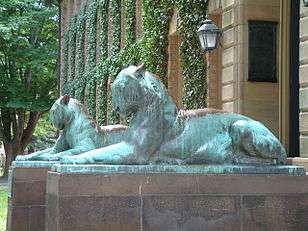Rutgers–Princeton Cannon War
The Rutgers-Princeton Cannon War refers a series of incidents involving two Revolutionary War cannons and a rivalry between the College of New Jersey in Princeton, New Jersey – now Princeton University – and Rutgers College – now Rutgers University – in New Brunswick, New Jersey.
History
Rutgers and Princeton are both located in Central New Jersey, about 17 miles from each other. Princeton was founded in Elizabeth, New Jersey in 1746 and then relocated to Princeton 10 years later; Rutgers was founded in New Brunswick in 1766. In 1864, Rutgers educators George Cook and David Murray led a successful campaign to designate Rutgers as New Jersey's designated land-grant university, overcoming competition from other colleges in the state, notably Princeton. On November 6, 1869, Rutgers defeated Princeton in New Brunswick at the first intercollegiate football game on a field where Rutgers' College Ave Gymnasium now stands, adding to the rivalry between the two schools.
Two Revolutionary War cannons were left on the Princeton campus at the end of the war, although neither of them were used in the Battle of Princeton, as is often claimed.[1] "Big Cannon" is located behind Nassau Hall in the center of the quadrangle there, called "Cannon Green",[1] and "Little Cannon" is situated between Whig and Clio Halls.[2] For the War of 1812, "Big Cannon" was transported to New Brunswick to help defend the city against potential attack by the British, remaining on the Rutgers campus – where it was used for training during and after the Civil War by Rutgers cadets[3] – until it was taken back to Princeton in 1875 by the "Princeton Blues", a local militia. Unfortunately, the wagon it was being transported in broke down on the outskirts of Princeton, and the cannon did not reach the Princeton campus until 1836[1] when Leonard Jerome – who would become the maternal grandfather of Winston Churchill – led a large group of students who brought it to Nassau Hall. The cannon was then "planted", muzzle down, in its current location, in 1840.[2]
On the night of April 25, 1875 ten members of the Rutgers Class of 1877 set out to steal back "Big Cannon" from Princeton However, they were unable to move it, so instead they returned to New Brunswick with "Little Cannon".[3] Princeton responded with a raid on Rutgers, stealing some muskets, and the heads of the two colleges exchanged polite but demanding correspondence. Eventually, a joint committee settled the matter, and "Little Cannon" was returned to Princeton, escorted by the New Brunswick Police Chief.[2][4]

In October 1946, a contingent of Rutgers men slipped onto the Princeton campus and again tried to steal the famed cannon. This attempt was even more disastrous than the first. They attached one end of a heavy chain to the cannon and the other to their Ford automobile. Surprised by Princeton students and the police, they gunned the engine of the car so hard that the car was torn in half. The Rutgers students managed to escape, but with neither the car nor the cannon.
On the eve of the annual Rutgers-Princeton game in the fall of 1971 the cannon was apparently "stolen", again. A 4'x5' hole some 5 feet deep was found where the cannon sat. Campus police were baffled that the cannon had been taken given its extreme weight. After crime photos were taken, it appears that a hole had simply been dug next to cannon and the dirt from the hole used to bury it. Reports appeared in both the Rutgers Targum as well as the New Jersey and Princeton papers.
The cannon at Princeton is routinely painted red by Rutgers students, particularly in the week leading to Rutgers commencement as well as on other notable Rutgers dates. In February 2010, The war between loyal Rutgers and Princeton students became more than just "the painting of a cannon". In the depths of 2 feet (0.6 m) of snow, students not only painted the cannon and its surrounding concrete, but used spray paint to "tag" Princeton classroom buildings, dormitories, and libraries. Many Rutgers bumper stickers reading "Rutgers, Jersey Roots Global Reach" were placed all over campus.
In November 2011, a group of Rutgers students who went to paint the cannon in Princeton brought a video camera with them and made a documentary about the tradition. The footage became part of a larger project about the history of the Cannon War and its perception in the minds of current students today. The film, "Knights, Tigers, and Cannons. Oh My!", by Zack Morrison,[3] premiered at the New Jersey Film Festival in September 2012, and won the award for Best Student Film.
See also
References
Notes
- 1 2 3 Smagorinsky, Margaret. "Some Legends and Lore of Princeton University" Princeton University, 1993.
- 1 2 3 Leitch, Alexander. A Princeton Companion. Princeton, New Jersey: Princeton University Press, 1978
- 1 2 3 Stamato, Linda. "Rutgers and Princeton: Tradition, rivalry and the cannon wars" NJ.com (September 11, 2012)
- ↑ "Princeton's Old Cannon" New York Times (July 7, 1889]
Bibliography
- Demarest, William Henry Steele. History of Rutgers College: 1776-1924. (New Brunswick, NJ: Rutgers College, 1924). (No ISBN)
- Lukac, George J. (ed.), Aloud to Alma Mater. (New Brunswick, New Jersey: Rutgers University Press, 1966), 70-73. (No ISBN)
- McCormick, Richard P. Rutgers: a Bicentennial History. (New Brunswick, NJ: Rutgers University Press, 1966). ISBN 0-8135-0521-6
- Schmidt, George P. Princeton and Rutgers: The Two Colonial Colleges of New Jersey. (Princeton, NJ: Van Nostrand, 1964). (No ISBN)
- "Again, War Over A Cannon: Rivals Besmirch Princeton Gun," in Life. Vol. 35, No. 17. October 26, 1953. p. 147
External links
- Rutgers University
- Princeton University
- Knights, Tigers, and Cannons. Oh My!; a documentary about the Rutgers-Princeton Cannon War
